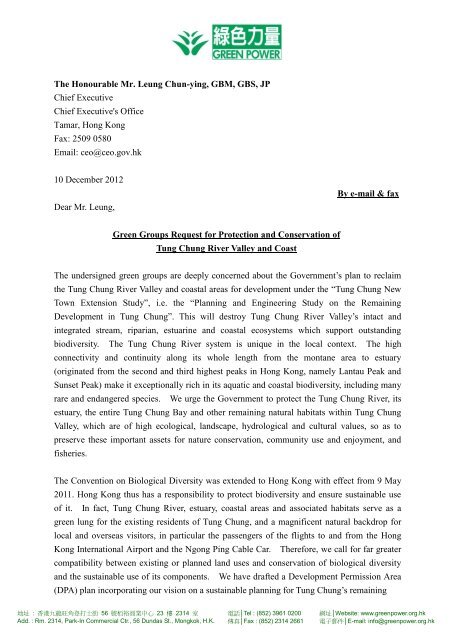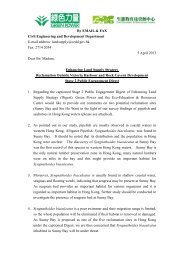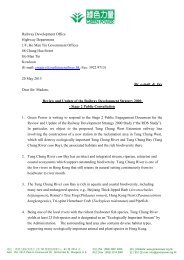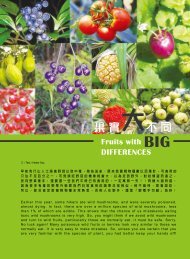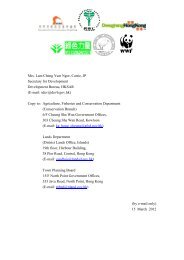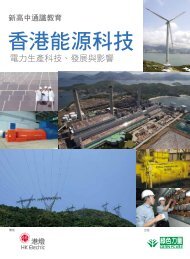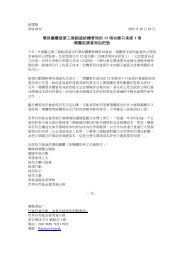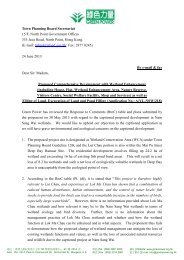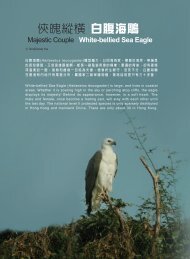Joint Letter to the Chief Executive, Mr. Leung Chun-ying, Requesting ...
Joint Letter to the Chief Executive, Mr. Leung Chun-ying, Requesting ...
Joint Letter to the Chief Executive, Mr. Leung Chun-ying, Requesting ...
Create successful ePaper yourself
Turn your PDF publications into a flip-book with our unique Google optimized e-Paper software.
c.c.:<strong>Mr</strong>s. LAM CHENG Yuet Ngor, Carrie, GBS, JP, <strong>Chief</strong> Secretary for Administration(Fax: 2882 0099; E-mail: cso@cso.gov.hk)<strong>Mr</strong>. CHAN Mo Po, Paul, MH, JP, Secretary for Development(Fax: 2845 3489; E-mail: sdev@devb.gov.hk)<strong>Mr</strong>. WONG Kam Sing, Secretary for <strong>the</strong> Environment(Fax: 2147 3287 ; E-mail: sen@enb.gov.hk)地 址 : 香 港 九 龍 旺 角 登 打 士 街 56 號 栢 裕 商 業 中 心 23 樓 2314 室 電 話 │Tel : (852) 3961 0200 網 址 │Website: www.greenpower.org.hkAdd. : Rm. 2314, Park-In Commercial Ctr., 56 Dundas St., Mongkok, H.K. 傳 真 │Fax : (852) 2314 2661 電 子 郵 件 │E-mail: info@greenpower.org.hk
19 June 2012<strong>Joint</strong> Green Groups’ Statement on Protection and Conservationof Tung <strong>Chun</strong>g River, Estuary, Coastal Areas and Associated Habitats1. The undersigned groups are deeply concerned about <strong>the</strong> Government’s plan <strong>to</strong> reclaim <strong>the</strong> Tung<strong>Chun</strong>g River Valley and coastal areas for development under <strong>the</strong> “Planning and Engineering Studyon <strong>the</strong> Remaining Development in Tung <strong>Chun</strong>g”, which will destroy Tung <strong>Chun</strong>g River Valley’sintact and integrated stream, riparian, estuarine and coastal ecosystems. These habitats suppor<strong>to</strong>utstanding biodiversity. Tung <strong>Chun</strong>g River is one of <strong>the</strong> few remaining major streams in HongKong which has not been overly affected by channelization or water pollution, and largely retainsits natural state throughout <strong>the</strong> whole river course from headwater <strong>to</strong> estuary. The Tung <strong>Chun</strong>gRiver system is unique in <strong>the</strong> local context. Its headwaters flow down from Hong Kong’s secondand third highest peaks, and run uninterrupted all <strong>the</strong> way <strong>to</strong> <strong>the</strong> shallow Tung <strong>Chun</strong>g Bay. Thehigh connectivity and continuity along its whole length from <strong>the</strong> montane area <strong>to</strong> estuary make itexceptionally rich in its aquatic and coastal biodiversity, including many rare and endangeredspecies. The surrounding land area also contains diverse habitat types, supporting manyecologically important animal and plant species in Hong Kong.2. We urge <strong>the</strong> Government <strong>to</strong> protect <strong>the</strong> Tung <strong>Chun</strong>g River (both channelized and natural sections,and its tributaries), its estuary, <strong>the</strong> entire Tung <strong>Chun</strong>g Bay and o<strong>the</strong>r remaining natural habitatswithin Tung <strong>Chun</strong>g Valley, which are of high ecological, landscape, hydrological and culturalvalues, so as <strong>to</strong> preserve natural resources for nature conservation, community use and enjoyment,and fisheries. In addition, we have prepared a recommended Development Permission Area (DPA)plan incorporating our vision for a sustainable future for Tung <strong>Chun</strong>g’s remaining natural areas forGovernment’s consideration.1
3. Tung <strong>Chun</strong>g has a special his<strong>to</strong>ry and a unique setting. It has been settled since <strong>the</strong> fall of <strong>the</strong>Sou<strong>the</strong>rn Sung Dynasty in 1279. The bay was <strong>the</strong> setting for a huge naval battle in 1810 when <strong>the</strong>Qing navy defeated <strong>the</strong> no<strong>to</strong>rious pirate Cheung Po Tsai. The Tung <strong>Chun</strong>g Fort and Tung <strong>Chun</strong>gBattery dated from <strong>the</strong>se times and are listed monuments. L<strong>ying</strong> between <strong>the</strong> forested slopes of LantauPeak and Nei Lek Shan, <strong>the</strong> bay with <strong>the</strong> immensely pho<strong>to</strong>genic fishing village on Ma Wan <strong>Chun</strong>g,<strong>the</strong> his<strong>to</strong>ric Hau Wong Temple in its coastal setting, and <strong>the</strong> sea grass and mangrove stands, offers aunique panorama and insight for visi<strong>to</strong>rs and locals alike. These aspects would disappear if Tung<strong>Chun</strong>g is fur<strong>the</strong>r developed.4. We would also note that <strong>the</strong> Convention on Biological Diversity was extended <strong>to</strong> Hong Kong wi<strong>the</strong>ffect from 9 May 2011. The implication of <strong>the</strong> extension is a commitment <strong>to</strong> develop andimplement best international practices for <strong>the</strong> conservation and sustainable use of biodiversity.There are now fur<strong>the</strong>r obligations for our future development plans <strong>to</strong> effectively manage andprotect our valuable ecological diversity within or outside <strong>the</strong> protected areas and ensure <strong>the</strong>irconservation and sustainable use. Under Article 8 of this Convention, each contracting partyshall:• Establish a system of protected areas or areas where special measures need <strong>to</strong> be taken <strong>to</strong> conservebiological diversity;• Develop, where necessary, guidelines for <strong>the</strong> selection, establishment and management of protectedareas or areas where special measures need <strong>to</strong> be taken <strong>to</strong> conserve biological diversity;• Regulate or manage biological resources important for <strong>the</strong> conservation of biological diversitywhe<strong>the</strong>r within or outside protected areas, with a view <strong>to</strong> ensuring <strong>the</strong>ir conservation and sustainableuse;• Promote <strong>the</strong> protection of ecosystems, natural habitats and <strong>the</strong> maintenance of viable populations ofspecies in natural surroundings;• Promote environmentally sound and sustainable development in areas adjacent <strong>to</strong> protected areaswith a view <strong>to</strong> fur<strong>the</strong>ring protection of <strong>the</strong>se areas;• Rehabilitate and res<strong>to</strong>re degraded ecosystems and promote <strong>the</strong> recovery of threatened species,inter alia, through <strong>the</strong> development and implementation of plans or o<strong>the</strong>r management strategies;• Endeavour <strong>to</strong> provide <strong>the</strong> conditions needed for compatibility between present uses and <strong>the</strong>conservation of biological diversity and <strong>the</strong> sustainable use of its components.5. Therefore, compatible landuse should be extended <strong>to</strong> Tung <strong>Chun</strong>g River, estuary, coastal areas andassociated habitats which can serve as a green lung for <strong>the</strong> existing residents of Tung <strong>Chun</strong>g. Ourvision for <strong>the</strong> Tung <strong>Chun</strong>g’s remaining natural areas is as follows:a. Protect and conserve high quality natural habitats which are of rich biodiversity and ecologicalvalue through conservation planning, management and moni<strong>to</strong>ring. In particular, Tung <strong>Chun</strong>gRiver, estuary, woodlands and <strong>the</strong> coast should not be exploited for any development andprotected statu<strong>to</strong>rily as “Site of Special Scientific Interest”, “Conservation Area” and “Coastal2
Protection Area” zones as illustrated in our recommended DPA plan for Tung <strong>Chun</strong>g remainingnatural areas. (See Appendix 1 regarding green groups’ recommended DPA plan for Tung<strong>Chun</strong>g’s remaining natural areas.)b. Promote compatible community use and enjoyment in <strong>the</strong> Tung <strong>Chun</strong>g River Valley and <strong>the</strong>estuary through environmental education and passive recreation activities. Ecologically-friendlyfacilities which encourage <strong>the</strong> public <strong>to</strong> assess Tung <strong>Chun</strong>g River and <strong>the</strong> estuary can beconsidered, for example, eco-trails, a riverside park, a nature education centre, resting places andlook-out <strong>to</strong>wers.c. Enhance <strong>the</strong> <strong>to</strong>urist appeal of Tung <strong>Chun</strong>g River Valley based on its river landscape and culturalheritage through improved linkage <strong>to</strong> existing Country Parks in Lantau, as Tung <strong>Chun</strong>g RiverValley is located amongst existing <strong>to</strong>urist spots including Hong Kong International Airport,Ngong Ping Cable Car, Po Lin Monastery and <strong>the</strong> Tian Tan Buddha Statue.6. In order <strong>to</strong> fur<strong>the</strong>r support <strong>the</strong> ecological value of Tung <strong>Chun</strong>g River, estuary, coastal areas andassociated habitats, a number of conservation groups have commenced ecological surveys in <strong>the</strong>seareas. The results will be released and submitted <strong>to</strong> <strong>the</strong> Government <strong>to</strong> facilitate environmentallyand socially sound planning for Tung <strong>Chun</strong>g’s remaining natural areas. The surveys cover a widerange of taxa groups and a summary of <strong>the</strong> results is presented below.7. Tung <strong>Chun</strong>g River and riparian zonesThe preliminary results show that Tung <strong>Chun</strong>g River is rich in freshwater fish species. Over 20freshwater fish species (11% of <strong>to</strong>tal number of freshwater species) can be found in <strong>the</strong> Tung<strong>Chun</strong>g River and five of <strong>the</strong>m (including Beijiang Thick-lipped Barb (Acrossocheilusbeijiangensis) and Giant Mottled Eel (Anguilla marmorata)) are considered <strong>to</strong> be of highconservation importance. In fact, Tung <strong>Chun</strong>g River is one of <strong>the</strong> last local streams which stillhas a natural estuary. Tung <strong>Chun</strong>g River and its riparian zones are also ecologically importantfor 25 amphibian and reptile species (22% of <strong>to</strong>tal number of amphibian and reptile species)including <strong>the</strong> endemic Romer’s Tree Frog (Liuixalus romeri) and Hong Kong Newt(Paramesotri<strong>to</strong>n hongkongensis) which are protected by law. At least 48 butterfly species (18%of <strong>to</strong>tal number of butterfly species) can be found in Tung <strong>Chun</strong>g’s remaining natural habitat, anda population of one rare butterfly species, Jhora Scrub Hopper (Aeromachus jhora) can be foundwithin <strong>the</strong> marsh inside Tung <strong>Chun</strong>g River.8. Tung <strong>Chun</strong>g Estuary and Tung <strong>Chun</strong>g BayTung <strong>Chun</strong>g Estuary is characterised by mudflat, mangrove, saltmarsh and seagrass habitats and<strong>the</strong> San Tau seagrass bed SSSI is located on its western side. The estuary is home <strong>to</strong> variousmangrove plant and animal species and is also <strong>the</strong> breeding and nursery ground for two horseshoecrab species, Chinese Horseshoe Crab (Tachypleus tridentatus) and Mangrove Horseshoe Crab(Carcinoscorpius rotundicauda)) and one pipefish species, Seaweed Pipefish (Syngnathusschlegeli), demonstrating its high ecological value and importance in local context. Tung <strong>Chun</strong>g3
Bay is also exceptional in terms of economically important juvenile fish and crustacean species,which shows that Tung <strong>Chun</strong>g Bay is an important nursery area of commercial fisheries resources.The bay is also an important foraging ground for some important wetland bird species likeSwinhoe’s Egret (Egretta eulophotes) and Pacific Reef Egret (Egretta sacra).9. Tung <strong>Chun</strong>g ValleyTung <strong>Chun</strong>g Valley is largely covered with wooded areas and several Fung Shui Woodlands areidentified. The secondary woodlands surrounding Tung <strong>Chun</strong>g Valley are good in quality and areused by many fauna species. These woodlands also contain protected plant species like IncenseTree (Aquilaria sinensis) which are of conservation importance. Four butterfly species ofconservation importance are recorded near <strong>the</strong> Tung <strong>Chun</strong>g woodlands, including Oriental StripedBlue (Lep<strong>to</strong>tes plinius), Peacock Royal (Tajuria cippus), Golden Birdwing (Troides aeacus) andCommon Birdwing (Troides helena). (See Appendix 2 for some highlighted key ecologicallyimportant species recorded in <strong>the</strong> Tung <strong>Chun</strong>g River, valley, estuary and bay.). Part of Tung<strong>Chun</strong>g River, its riparian habitats and its estuarine habitats have been severely damaged byhaphazard development over <strong>the</strong> last decade and it is time <strong>to</strong> provide appropriate planning andprotection <strong>to</strong> <strong>the</strong> remaining key sites.10. In view of <strong>the</strong> intactness, uniqueness and intricate ecology of Tung <strong>Chun</strong>g River Valley, estuaryand coastal areas and <strong>the</strong> social benefits of conserving <strong>the</strong>se areas for public use and <strong>to</strong>uristattraction, any adverse impacts of development or incompatible uses in <strong>the</strong>se areas must beavoided. Therefore, we strongly urge <strong>the</strong> government <strong>to</strong>:a. Prohibit civil engineering work, channelization and reclamation in Tung <strong>Chun</strong>g River courses andbanks, estuary and <strong>the</strong> entire Tung <strong>Chun</strong>g Bay.b. Prohibit any discharge of effluents and connection of outfalls <strong>to</strong> Tung <strong>Chun</strong>g River channels andesturary. Any landuse and activity that brings about water pollution must be removed from Tung<strong>Chun</strong>g River banks and <strong>the</strong> shores of Tung <strong>Chun</strong>g Bay.c. Rehabilitate <strong>the</strong> channelized/ damaged artificial river sections.d. Adopt our recommended DPA plan <strong>to</strong> guide a sustainable planning and development in Tung<strong>Chun</strong>g.e. Terminate <strong>the</strong> present planning and engineering study on <strong>the</strong> remaining development in Tung<strong>Chun</strong>g and not <strong>to</strong> fast-track <strong>the</strong> landuse planning, engineering feasibility and EIA study processes.We consider that <strong>the</strong> present proposed plan <strong>to</strong> reclaim Tung <strong>Chun</strong>g Bay, with new <strong>to</strong>wndevelopment as <strong>the</strong> decided objective, pre-empts <strong>the</strong> landuse planning and EIA process.Co-signed GroupsDesigning Hong KongEco-Education & Resources CentreGreen Lantau AssociationGreen PowerHong Kong Bird Watching SocietyThe Conservancy AssociationWWF-Hong Kong4
Appendix 1: Green Groups’ recommended DPA plan for a sustainable planning for Tung <strong>Chun</strong>g River, estuary, coastal areas and associated habitats.5
Appendix 2: List of some highlighted key ecologically important species recorded in Tung <strong>Chun</strong>g River, Valley, estuary and bay.中 文 名 稱English Name Scientific NameChinese NameTung <strong>Chun</strong>g River and Riparian ZoneRarity Conservation Status Required HabitatsRomer's Tree Frog Liuixalus romeri 盧 氏 小 樹 蛙 Endemic <strong>to</strong> HongKongProtected under Cap. 170IUCN: Endangered 1Fellowes et al. (2002):Potential Global Concern 2Riparian zones (woodlands/ vegetated areas; butalso see below)Hong Kong NewtParamesotri<strong>to</strong>n香 港 瘰 螈Restricted <strong>to</strong> coastalProtected under Cap. 170Found in <strong>the</strong> main stream and tributaries of TunghongkongensisSouth China butIUCN: Near Threatened 1<strong>Chun</strong>g River Systemfairly widespreadFellowes et al. (2002):locallyPotential Global Concern 2Short-legged ToadXenophrys短 腳 角 蟾All confirmedAFCD: Species ofSmall hill streams and wooded riparian zones; smallbrachykolosrecords are fromConservation Concern 3tributaries associated with Tung <strong>Chun</strong>g RiverHong Kong.IUCN: Endangered 1provide suitable breeding habitats for this species.Fellowes et al. (2002):Potential Global Concern 2BeijiangAcrossocheilus北 江 光 唇 魚PopulationsAFCD: Species ofStreams with natural bot<strong>to</strong>m (gravel and sand);Thick-lipped Barbbeijiangensisconsidered <strong>to</strong> beConservation Concern 4found in <strong>the</strong> main stream and tributaries of Tungnative appear inFellowes et al. (2002):<strong>Chun</strong>g River System.only Hong KongGlobal Concern 2Island and Lantau;distribution highly6
English NameScientific Name中 文 名 稱Chinese NameRarity Conservation Status Required Habitatsrestricted.Giant Mottled Eel Anguilla marmorata 花 鰻 鱺 Ra<strong>the</strong>r restricted indistribution andpopulation size verysmall; threatened byover-harvesting andpopulation trend islikely <strong>to</strong> bedecreasingAFCD: Species ofConservation Concern 5China Red Data Book:Endangered 5China Species Red List:Endangered 6Class II State ProtectedSpecies in China 6Fellowes et al. (2002):Global Concern 2Diadromous species; inhabits streams with naturalstream bed (gravel and sand); <strong>the</strong> stream-oceancorridor should not be blocked (i.e. channelization atcertain section, culverted); stream flow and streambed should remain natural (stream flow should notbe fur<strong>the</strong>r reduced); simply speaking, <strong>the</strong> wholestream should be preserved for protecting thisspeciesJhora ScrubHopperAeromachus jhora 寬 鍔 弄 蝶 Rare 7 AFCD: Rare 7 A population was found within <strong>the</strong> marsh inside Tung<strong>Chun</strong>g River.Hong KongSpiran<strong>the</strong>s香 港 綬 草Threatened byProtected under Cap. 96Stream and riparian zone.Spiran<strong>the</strong>shongkongensisoverharvestingand 586.Pitcher Plant Nepen<strong>the</strong>s mirabilis 豬 籠 草 Threatened byProtected under Cap. 96Riparian zone.Tung <strong>Chun</strong>g Estuary and Tung <strong>Chun</strong>g Bayoverharvestingand 586.Burmese Python Python molurus 蟒 蛇 Widespread in HongKong but rare inSouth ChinaProtected under Cap 170and 586IUCN: Near Threatened 1China Species Red List:Critically Endangered 6Woodlands, mangrove, saltmarsh, stream coursesand vegetated riparian zone7
English NameScientific Name中 文 名 稱Chinese NameRarity Conservation Status Required HabitatsChina Red Data Book:Critically Endangered 6Class I State ProtectedSpecies in China 6Fellowes et al. (2002):Potential RegionalConcern 2ChineseTachypleus中 國 鱟Restricted mostly <strong>to</strong>IUCN - Data DeficientCoastal bays, Intertidal soft shore, and <strong>the</strong> bot<strong>to</strong>m ofHorseshoe Crabtridentatus<strong>the</strong> DeepChina Species Red List:open seaBay and rare inEndangeredo<strong>the</strong>r parts of HongTheir abundance hasKong 10declined substantially withlow density on local shoresin Hong Kong 10 .MangroveCarcinoscorpius圓 尾 鱟Mainly in Deep BayIUCN - Data DeficientCoastal bays, Intertidal soft shore, and <strong>the</strong> bot<strong>to</strong>m ofHorseshoe Crabrotundicaudaand Lantau Island.China Species Red List:open seaAlso recorded in LukVulnerableKeng and Lai ChiTheir abundance hasWo 10declined substantially withlow density on local shoresin Hong Kong 10 .Seaweed Pipefish Syngnathus schlegeli 舒 氏 海 龍 Juveniles were IUCN – Not Assessed Coastal bays, Intertidal soft shore, and <strong>the</strong> bot<strong>to</strong>m of8
English NameScientific Name中 文 名 稱Chinese NameRarity Conservation Status Required Habitatsdiscovered in Shaopen seaLo Wan and Tung<strong>Chun</strong>g baysMainly distributed innor<strong>the</strong>rn part of Lantaucoastal waters, also knownfrom Tung Ping Chau 18Alliga<strong>to</strong>r PipefishSyngnathoides棘 海 龍Adults wereIUCN – Not Assessedbiaculeatusdiscovered in SunnyBay, Tung <strong>Chun</strong>gMainly distributed inBay, Hau Hok Wannor<strong>the</strong>rn part of Lantauand Sha Lo Wancoastal watersSwinhoe's Egret Egretta eulophotes 黃 咀 白 鷺 scarce springpassage migrantIUCN VulnerableClass II State ProtectedSpecies in ChinaFellowes et al. (2002):Global Concernmainly intertidal mudflats and marshesCollared Crow Corvus <strong>to</strong>rquatus 白 頸 鴉 Uncommon andlocalised residentIUCN Near ThreatenedFellowes et al. (2002):Local ConcernwetlandsPacific Reef Egret Egretta sacra 岩 鷺 Uncommon resident China Red Data Book: rareCoastal areasClass II State ProtectedSpecies in China9
English NameScientific Name中 文 名 稱Chinese NameRarity Conservation Status Required HabitatsFellowes et al. (2002):Local ConcernNo common nameLigustrum punctifolium 斑 葉 女 貞 Very rare; foundListed under “Rare andMangrove area; it should be noted that although <strong>the</strong>(A rare shrubonly at several sitesPrecious Plants of HongTung <strong>Chun</strong>g population is small, it is very far awayspecies)in Hong Kong andKong” 13 .from <strong>the</strong> one at NE New Terri<strong>to</strong>ries, so it should be ahas not beendistinct population requiring special attention.recorded fromMainland China; <strong>the</strong>o<strong>the</strong>r populationwas found inVietnam.O<strong>the</strong>r key records: Fish larvae from 8 families including Callionymidae, Clupeidae, Engraulidae, Gobiidae, Lutjanidae, Sillaginidae, Sciaenidae and Syngnathidae and onecrustacean larvae from Portunidae family are also recorded. Most of <strong>the</strong>se families have species which are economically important fisheries resources.Tung <strong>Chun</strong>g ValleyTokay Gecko Gekko gecko 大 壁 虎 Uncommon andrestricted indistribution 15China Red Data Book:Endangered 15China Species Red List:Endangered 4Class II State ProtectedSpecies in China 4Fellowes et al. (2002):Regional Concern 2Cliffs or boulder piles surrounded by thick brush/woodland.Chinese Bull Frog Hoplobatrachus 虎 紋 蛙 Uncommon China Species Red List: Active and abandoned agricultural lands; <strong>the</strong> riparian10
English Name中 文 名 稱Rarity Conservation Status Required HabitatsScientific NameChinese Namechinensis Vulnerable 4zones along Tung <strong>Chun</strong>g River system also provideClass II State ProtectedSpecies in China 4suitable habitats.Romer's Tree Frog Liuixalus romeri 盧 氏 小 樹 蛙 Endemic <strong>to</strong> HongKongEmerald Dove Chalcophaps indica 綠 翅 金 鳩 China Species RedList: NearThreatenedChina Red DataBook: VulnerableFellowes et al. (2002):Potential RegionalConcern 2Protected under Cap. 170.IUCN: Endangered 1Fellowes et al. (2002):Potential Global Concern 2CRDB vulnerableWoodlands, orchards, abandoned agricultural landsand even roadside plantation areas.Wooded areasEurasian EagleBubo bubo 鵰 鴞 China Red DataCRDB rare; PRC grade IIHillsides with grassy/ shruby vegetationOwlBook: Rareprotected animalClass II StateProtected Speciesin ChinaFellowes et al.(2002): RegionalConcern 2Golden Birdwing Troides aeacus 金 裳 鳳 蝶 Rare 16 Protected under Cap. 58611
English NameScientific Name中 文 名 稱Chinese NameRarity Conservation Status Required HabitatsAFCD: Species ofConservation Concern 16Fellowes et al. (2002):Local Concern 2Common Birdwing Troides helena 裳 鳳 蝶 Uncommon 16 Protected under Cap. 170and 586Regularly recorded from one Fung Shui Woodland atTung <strong>Chun</strong>gOriental StripedBlueAFCD: Species ofConservation Concern 16China Species Red List:Near-threatened 4Lep<strong>to</strong>tes plinius 細 灰 蝶 Very rare 17 . AFCD: Species ofConservation Concern 17Fellowes et al. (2002):Local Concern 2A population was found in Tung <strong>Chun</strong>g ValleyPeacock Royal Tajuria cippus 雙 尾 灰 蝶 Rare Local Concern 2 Wooded areasIncense Tree Aquilaria sinensis 土 沉 香 Used <strong>to</strong> bewidespread in HongKong but manymature trees havebeen cut for <strong>the</strong>agar wood in recentyearsProtected under Cap. 586Listed under “Rare andPrecious Plants of HongKong” 13Near-threatened in China 13China Species Red List:Vulnerable 4Class II State ProtectedSpecies in China 13Lowland woodland12
English NameScientific Name中 文 名 稱Chinese NameRarity Conservation Status Required HabitatsLittle-leavedRoureaGmelina chinensis 石 梓 Common Listed under “Rare andPrecious Plants of HongKong” 13Vulnerable in China 13Considered <strong>to</strong> be rare andendangered inGuangdong 13Lowland woodlandWhite Yam Dioscorea hispida 白 薯 茛 Rare Nil Lowland woodlandToo<strong>the</strong>d BlackGymnosphaera細 齒 黑 桫 欏 Very rare Protected under Cap. 96Has been recorded in Tung <strong>Chun</strong>g; inhabits thickTree-fernhancockiiand 586forest of valleys and stream sides.Listed under “Rare andPrecious Plants of HongKong” 13Vulnerable in China 13Class II State ProtectedSpecies in China 13References:1 www.iucnredlist.org2 Fellow, J. R. et al. (2002). Wild animals <strong>to</strong> watch: terrestrial and freshwater fauna of conservation concern in Hong Kong. In Hodgkiss, I.J. (ed.).Memoirs of <strong>the</strong> Hong Kong Natural His<strong>to</strong>ry Society, No. 19, Hong Kong. pp.123-159.3 http://www.afcd.gov.hk/tc_chi/conservation/hkbiodiversity/database/popup_record.asp?id=2986&lang=tc4 http://www.afcd.gov.hk/tc_chi/conservation/hkbiodiversity/database/popup_record.asp?id=2984&lang=tc5 http://www.afcd.gov.hk/english/conservation/hkbiodiversity/database/popup_record.asp?id=2975&lang=tc13
6 www.baohu.org7 http://www.afcd.gov.hk/tc_chi/conservation/hkbiodiversity/database/popup_record.asp?id=3982&lang=tc8 Tse, P. Nip, T.H.M. and Wong, C.K. 2008. Nursery function of mangrove: a comparison within mudflat in terms of fish species composition and fish diet.Estuarine, Coastal and Shelf Science 80, 235-242.9 Nip, T.H.M. and Wong, C.K. 2010. Juvenile fish assemblages in mangrove and non-mangrove soft-shore habitats in Eastern Hong Kong. ZoologicalStudies 49, 760-778.10 Li H.Y. 2008. The Conservation of Horseshoe Crabs in Hong Kong. MPhil. Thesis, City University of Hong Kong, 250 pp.11 http://www.afcd.gov.hk/english/conservation/con_mar/con_mar_hor/con_mar_hor.html12 http://www.afcd.gov.hk/english/conservation/con_wet/con_wet_sea/con_wet_sea.html13 Hu, Q.-m., Wu, T.-l., Xia, N.-h., Xing, F.-w., Lai, P.C.C. and Yip, K.-l. 2003. Rare and Precious Plants of Hong Kong. Agriculture, Fisheries andConservation Department, Hong Kong Government, Hong Kong.14 Karsen, S.J., Lau, M.W.-n. and Bogadek, A. 1998. Hong Kong Amphibians and Reptiles. Provisional Urban Council, Hong Kong.15 http://www.afcd.gov.hk/english/conservation/hkbiodiversity/database/popup_record.asp?id=3150&lang=en16 http://www.afcd.gov.hk/english/conservation/hkbiodiversity/database/popup_record.asp?id=2725&lang=en17 http://www.afcd.gov.hk/english/conservation/hkbiodiversity/database/popup_record.asp?id=2487&lang=en18 Yvonne Sadovy and Andrew Cornish. 2000. Reef Fishes of Hong Kong. Hong Kong University Press.14


